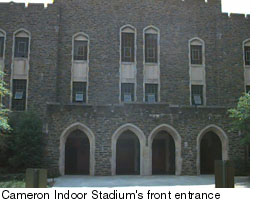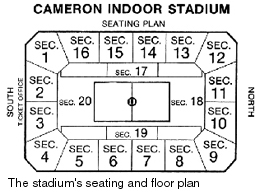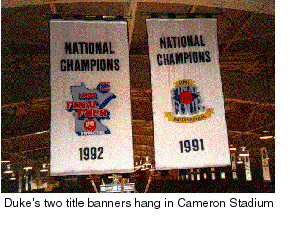

 Cameron Indoor Stadium has been a perfect home for the Duke University
basketball program. Conceived on the back of a matchbook cover and
renovated in the late 1980s at a cost of $2 million, Cameron has been
the site of hundreds of Blue Devil victories and more than a few
memories and stories of the Cameron Crazies, the great players, the
classic finishes and the incredible coaching.
Cameron Indoor Stadium has been a perfect home for the Duke University
basketball program. Conceived on the back of a matchbook cover and
renovated in the late 1980s at a cost of $2 million, Cameron has been
the site of hundreds of Blue Devil victories and more than a few
memories and stories of the Cameron Crazies, the great players, the
classic finishes and the incredible coaching.
More than a few of those victories have been influenced by the electric atmosphere within its Gothic halls.
Legend has it that it all began with a book of matches, which for a town and a school founded on local tobacco fortunes seems a promising way to start.
It was on the cover of a book of matches that Eddie Cameron and Wallace Wade first sketched out the plan for Duke�s Indoor Stadium in 1935. The story may be a myth (the matchbook has never been found), but then the Indoor Stadium that emerged from those first scribblings lends itself to the propagation of myths. ,p> For 60 years, spectators, players, and coaches have understood the unique magic of the Indoor Stadium (eventually named after long-time Duke Athletic Director Eddie Cameron, a legend in his own right).
It�s the intimacy of the arena, the unique seating arrangement that puts the wildest fans right down on the floor with the players. It�s the legends that were made there, the feeling of history being made with every game. And it�s something more than either of these, something indescribable that comes from the building itself. No one who has experienced it will ever forget it.
Whether or not the matchbook story is true, it is a fact that the official architectural plans for the Stadium were drawn up by the Philadelphia firm of Horace Trumbauer, Architect. Trumbauer was a self-made man, a poor boy who left school at 16 to apprentice himself as a draftsman to a local architect. In 1890, at the age of 22, he opened his own office and quickly rose to prominence in the Northeast. His designs for the mansions and estates of wealthy northeastern magnates brought him to the attention of James Buchanan Duke, North Carolina tobacco baron. Duke commissioned the architect to design his New York town home during the early part of the century.
In 1924, when Duke created the $40 million Duke Endowment that turned Trinity College into Duke University, he called on Trumbauer to design the new University Campus.
 In recent years it has come to light that the plans for the campus, as
well as designs for later buildings including the stadium, were drawn
up not by Trumbauer himself (although his name appeared on all the
blueprints) but by his chief designer, Julian Abele, one of the
nation�s first black architects. Abele, a brilliant architecture
student at the University of Pennsylvania, was brought to Trumbauer�s
attention shortly after his graduation in 1902. Trumbauer was so
impressed with Abele�s talents that he not only hired him but paid
his way through the prestigious Ecole des Beaux Arts in Paris. Abele
stands as the first African-American ever to graduate from the school.
In recent years it has come to light that the plans for the campus, as
well as designs for later buildings including the stadium, were drawn
up not by Trumbauer himself (although his name appeared on all the
blueprints) but by his chief designer, Julian Abele, one of the
nation�s first black architects. Abele, a brilliant architecture
student at the University of Pennsylvania, was brought to Trumbauer�s
attention shortly after his graduation in 1902. Trumbauer was so
impressed with Abele�s talents that he not only hired him but paid
his way through the prestigious Ecole des Beaux Arts in Paris. Abele
stands as the first African-American ever to graduate from the school.
The original design for the Indoor Stadium was significantly less grand than the one from which the building was actually constructed. That first plan called for 5,000 basketball "sittings", and even that number was considered extravagant, at least by Trumbauer, who originally had proposed 4,000 seats. In a letter to Dr. William P. Few, President of Duke, Trumbauer said: "For your information Yale has in its new gymnasium a basket ball (sic) court with settings for 1,600 ... I think the settings for 8,000 people is rather liberal ... the Palestra at the University of Pennsylvania seats 9,000."
The original building was a domed structure with 16-feet steel ceiling spans and a 90-by 45-foot playing court. Obviously, Dr. Few must have insisted on something more spectacular.
As important as the size of the Stadium was its external appearance. It was vital that the building be aesthetically integrated with the original West Campus buildings. For this reason, building stone was taken from the Duke quarry in nearby Hillsborough, N.C., where all the stone for the original campus had been found. Building on the Stadium proceeded quickly. The stone had to be laid in temperate weather, for in extremely cold temperatures, the mortar would freeze. The building was finished in nine months.
Thus the Stadium was ready to be opened by the first of the new year, 1940. The final cost: $400,000 (which Duke finished paying after the football team won the Sugar Bowl in 1945). In 1972, Eddie Cameron estimated that a similar structure built in the present day would cost at least $3.5 million.
Duke�s new Indoor Stadium was officially opened on January 6, 1940. Touring the building before the evening ceremony and subsequent game, local city officials were "speechless." Said Chamber of Commerce President Col. Marion B. Fowler, "It is so colossal and so wonderful ... This building will not only be an asset to the university but to the entire community as well." Chamber Secretary Frank Pierson concurred, "There are no superlatives for it."
 But Duke�s Indoor Stadium was a structure of superlatives. The arena
measured 262-feet long by 175-feet wide and was the East Coast�s
largest indoor stadium south of the Palestra in Philadelphia. Nine
fixed steel frames spanned the ceiling at 26-foot intervals, which
"provided an exceptionally good sight line." Seating for 8,800
included 3,500 folding bleacher seats on the floor designated, then
as today, for the exclusive use of undergraduates. Maximum capacity
was 12,000. A total of 16 ramps in the upper level helped prevent
bottlenecks. It was according to the program issued the opening
night, "one of the most modern and complete physical education
buildings in the country."
But Duke�s Indoor Stadium was a structure of superlatives. The arena
measured 262-feet long by 175-feet wide and was the East Coast�s
largest indoor stadium south of the Palestra in Philadelphia. Nine
fixed steel frames spanned the ceiling at 26-foot intervals, which
"provided an exceptionally good sight line." Seating for 8,800
included 3,500 folding bleacher seats on the floor designated, then
as today, for the exclusive use of undergraduates. Maximum capacity
was 12,000. A total of 16 ramps in the upper level helped prevent
bottlenecks. It was according to the program issued the opening
night, "one of the most modern and complete physical education
buildings in the country."
Originally the largest indoor arena in the South, Cameron is today one of the smallest in the nation. Nevertheless, its stature grows from year-to-year. Sellout crowds, top 25 rankings, and championships of every variety have become the norm. The "creative harassment" of student spectators has given Duke the honor of being known as "one of the toughest road games in the USA," according to the USA Today and any visiting team that has ever played in Cameron.
Cameron Indoor Stadium has remained very much the same over the last 60 years. New seating, high tech electronics, and a fresh coat of paint have not altered, but rather enhanced, Cameron�s most enduring characteristic ... its spirit. It is still a building of superlatives.
Adapted from "Home Court - Fifty Years of Cameron Indoor Stadium" by Hazel Landwehr.
 Return to the Main History Page
Return to the Main History Page
 More information on Duke's Championship Seasons
More information on Duke's Championship Seasons
 Explore the history of the Blue Devil mascot
Explore the history of the Blue Devil mascot
 View Duke's All-time leaders and records against the ACC
View Duke's All-time leaders and records against the ACC
